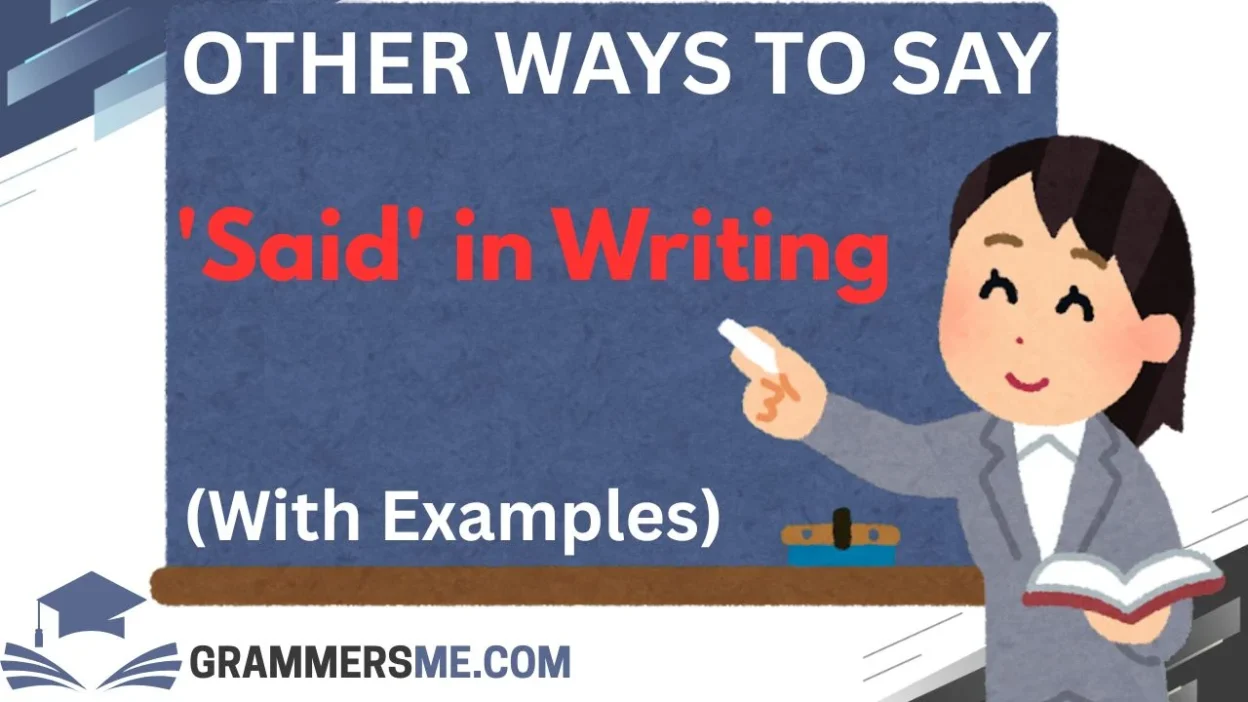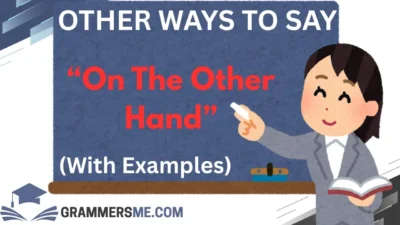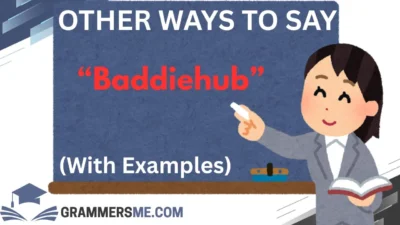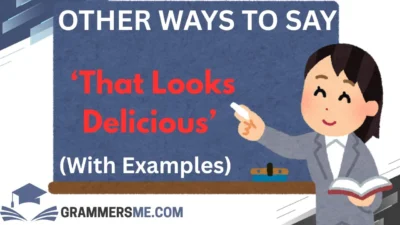When it comes to writing, finding the right words is essential for expressing thoughts with clarity and warmth. The word “said” is one of the most commonly used in dialogue or reporting speech, but overusing it can make your writing feel mechanical.
By exploring alternatives, you can bring your writing to life, adding nuance and emotion that resonates with your readers. Whether you’re writing a casual conversation or a more formal narrative, these alternatives will help you communicate with care and authenticity.
What Does “Said” Mean?
“Said” is the past tense of “say” and is commonly used to indicate that someone has spoken or expressed something. It’s an essential verb in communication, but relying too much on it can make your writing sound repetitive. By diversifying your language, you give the text a richer tone, enhancing its emotional impact.
Is It Professional/Polite to Say “Said”?
“Said” is certainly professional and polite when used appropriately. However, in more nuanced writing, especially in creative or formal contexts, alternatives to “said” can lend a more specific tone to a conversation or statement. The key is knowing when to use it and when a stronger or more descriptive verb might better convey the emotion or intention behind the words.
1. Stated
Meaning: To express something clearly and firmly.
Explanation: “Stated” is often used when someone is delivering a statement in a clear and authoritative way. It conveys that the person is making their point known without room for ambiguity.
Scenario Example:
John stated, “We need to finish this project by Friday.”
Best Use: In professional or formal settings when clarity is important.
Tone: Neutral and authoritative.
Not Use: In casual conversations or when a softer tone is needed.
2. Declared
Meaning: To announce or proclaim something with emphasis.
Explanation: “Declared” conveys certainty and strong intention. It’s often used when someone is asserting something publicly or formally.
Scenario Example:
The mayor declared, “The new park will be open next month.”
Best Use: When you want to add a sense of formality or weight to the words.
Tone: Confident, assertive.
Not Use: In informal dialogues where a softer tone is needed.
3. Remarked
Meaning: To say something, usually in a brief or offhand manner.
Explanation: This verb implies a more casual or thoughtful expression. It’s perfect for conversations where the speaker is offering a comment, often without the need for full emphasis.
Scenario Example:
She remarked, “It’s so lovely out today, isn’t it?”
Best Use: In informal settings or when offering a quick opinion or observation.
Tone: Casual, conversational.
Not Use: When formality or seriousness is required.
4. Mentioned
Meaning: To refer to something in passing.
Explanation: “Mentioned” indicates that something was spoken briefly or without elaboration. It’s often used when the speaker touches on a topic without focusing on it for long.
Scenario Example:
He mentioned that he would be attending the event tomorrow.
Best Use: When referring to something in passing or making a brief reference.
Tone: Neutral.
Not Use: When the statement requires emphasis or importance.
5. Explained
Meaning: To make something clear or understandable.
Explanation: “Explained” is used when someone clarifies or provides more details about something. It’s perfect for educational or informative contexts where the speaker needs to break down information.
Scenario Example:
The teacher explained, “To solve this equation, you need to follow these steps.”
Best Use: In instructional or informative writing.
Tone: Educational, clear.
Not Use: When the speaker is just offering a simple statement or opinion.
6. Insisted
Meaning: To demand or state something with emphasis, often with strong emotion or urgency.
Explanation: This word suggests a sense of persistence or firmness. It’s used when someone is asserting their point or belief with unwavering certainty.
Scenario Example:
She insisted, “I won’t go unless I’m sure it’s safe.”
Best Use: When conveying strong emotion, determination, or urgency.
Tone: Firm, insistent.
Not Use: When a softer or more casual tone is needed.
7. Asked
Meaning: To inquire or request information.
Explanation: “Asked” is often used to introduce a question or inquiry. It can also express a polite request, depending on the context.
Scenario Example:
He asked, “Can you help me with this?”
Best Use: When someone is making an inquiry or request.
Tone: Polite, neutral.
Not Use: When the speaker is not actually asking a question.
8. Replied
Meaning: To respond to something that has been said.
Explanation: “Replied” is used when someone is responding to a previous statement or question. It helps indicate that the conversation is ongoing.
Scenario Example:
She replied, “Yes, I’d love to join you for dinner.”
Best Use: In dialogues where someone is responding directly to a question or statement.
Tone: Neutral, conversational.
Not Use: When someone is making an original statement.
9. Pointed Out
Meaning: To highlight or draw attention to something.
Explanation: “Pointed out” is used when the speaker wants to emphasize something or make sure the listener notices an important detail.
Scenario Example:
He pointed out, “This document needs to be signed before we proceed.”
Best Use: When stressing an important detail or clarification.
Tone: Helpful, informative.
Not Use: When no special emphasis is required.
10. Admitted
Meaning: To confess or acknowledge something, often reluctantly.
Explanation: “Admitted” is used when someone acknowledges something, usually after some hesitation or in the context of a confession.
Scenario Example:
She admitted, “I forgot to submit the report on time.”
Best Use: When the speaker is confessing or revealing something.
Tone: Honest, slightly apologetic.
Not Use: When there’s no admission or confession involved.
11. Claimed
Meaning: To assert something, sometimes without proof or in a contentious manner.
Explanation: “Claimed” is used when someone states something that may or may not be true, often implying doubt or controversy.
Scenario Example:
He claimed that he had finished the project, but the report said otherwise.
Best Use: When the statement is disputed or unverified.
Tone: Neutral or skeptical.
Not Use: When the statement is clearly factual or undisputed.
12. Confirmed
Meaning: To affirm or verify something.
Explanation: “Confirmed” is used when the speaker is verifying or assuring the truth of something.
Scenario Example:
The secretary confirmed, “The meeting is scheduled for 2 p.m.”
Best Use: In professional or formal contexts when accuracy is crucial.
Tone: Authoritative, clear.
Not Use: When no verification is needed.
13. Argued
Meaning: To express a point of view, often in a confrontational or debated manner.
Explanation: “Argued” suggests that the person is presenting a case or viewpoint in a debate or disagreement.
Scenario Example:
She argued, “The policy needs to be revised for it to be effective.”
Best Use: When someone is presenting an argument or trying to persuade others.
Tone: Assertive, sometimes confrontational.
Not Use: In casual or non-confrontational situations.
14. Suggested
Meaning: To propose an idea or recommendation.
Explanation: “Suggested” is used when the speaker offers a proposal or an idea, often in a gentle and less forceful manner.
Scenario Example:
He suggested, “Maybe we should reschedule the meeting for next week.”
Best Use: When offering ideas or alternatives in a collaborative setting.
Tone: Friendly, considerate.
Not Use: When the situation calls for a stronger command or directive.
15. Observed
Meaning: To make a remark based on what is seen or perceived.
Explanation: “Observed” is used when someone is making a statement based on careful attention or reflection.
Scenario Example:
She observed, “The team has really come together in the past few weeks.”
Best Use: In thoughtful or reflective conversations.
Tone: Reflective, considerate.
Not Use: When someone is giving instructions or commands.
16. Revealed
Meaning: To make something known, often something previously hidden or secret.
Explanation: “Revealed” suggests that the speaker is disclosing something that was previously unknown or concealed.
Scenario Example:
He revealed, “I’ve been working on a new project for months.”
Best Use: When sharing new or confidential information.
Tone: Dramatic, informative.
Not Use: When there’s no element of surprise or disclosure.
17. Suggested
Meaning: To offer a recommendation or idea.
Explanation: “Suggested” is often used when the speaker proposes something, but it’s not forceful. It’s a gentle way of offering an option.
Scenario Example:
She suggested, “Why don’t we try this approach next time?”
Best Use: When you want to offer an idea without imposing it.
Tone: Light, collaborative.
Not Use: In situations where a clear decision is required.
18. Exclaimed
Meaning: To say something with strong emotion, often loudly.
Explanation: “Exclaimed” is used when someone expresses something with high emotion or surprise. It’s often associated with excitement or strong feelings.
Scenario Example:
She exclaimed, “I can’t believe we won!”
Best Use: When conveying surprise, excitement, or strong feelings.
Tone: Energetic, emotional.
Not Use: In calm or serious conversations.
19. Reiterated
Meaning: To say something again, often for emphasis.
Explanation: “Reiterated” is used when someone repeats their point to make it clearer or more emphatic.
Scenario Example:
He reiterated, “We must meet the deadline, no exceptions.”
Best Use: When emphasizing an important point.
Tone: Emphatic, assertive.
Not Use: When repetition is unnecessary.
20. Answered
Meaning: To respond to a question or statement.
Explanation: “Answered” is used when someone responds directly to an inquiry, clarifying or providing information.
Scenario Example:
She answered, “Yes, I’m available for the meeting at 3 p.m.”
Best Use: When someone responds to a question or inquiry.
Tone: Neutral, polite.
Not Use: When no response is needed.
21. Advised
Meaning: To offer advice or guidance.
Explanation: “Advised” is often used when the speaker is offering suggestions or recommendations, usually based on expertise or experience.
Scenario Example:
He advised, “I think it would be wise to take the weekend off.”
Best Use: When providing counsel or professional advice.
Tone: Professional, helpful.
Not Use: When a direct command or statement is required.
22. Cautioned
Meaning: To warn or advise with caution.
Explanation: “Cautioned” is used when someone is urging caution or highlighting potential risks.
Scenario Example:
She cautioned, “Make sure to double-check your work before submitting it.”
Best Use: When warning someone about potential risks or issues.
Tone: Cautionary, concerned.
Not Use: In situations where no caution is needed.
23. Murmured
Meaning: To speak in a low or soft voice, often indicating secrecy or tenderness.
Explanation: “Murmured” is used when someone speaks quietly, often conveying a sense of intimacy or secrecy.
Scenario Example:
He murmured, “I love you.”
Best Use: When expressing something tender, secretive, or private.
Tone: Soft, intimate.
Not Use: In loud or formal settings.
24. Whispered
Meaning: To speak very quietly, often to ensure privacy or secrecy.
Explanation: “Whispered” is used when someone speaks so softly that only a few people can hear them.
Scenario Example:
She whispered, “Let’s meet later after everyone leaves.”
Best Use: When sharing something confidential or secretive.
Tone: Quiet, secretive.
Not Use: In public or open environments.
25. Shouted
Meaning: To speak loudly, often in anger or excitement.
Explanation: “Shouted” is used when someone speaks with a loud, forceful tone, usually to express anger, excitement, or urgency.
Scenario Example:
He shouted, “Watch out!”
Best Use: When expressing urgency, anger, or extreme excitement.
Tone: Loud, forceful.
Not Use: In calm or formal contexts.
26. Observed
Meaning: To note or mention something thoughtfully.
Explanation: Similar to “remarked,” this term is often used when the speaker is reflecting on or commenting on a situation.
Scenario Example:
She observed, “It’s amazing how much progress we’ve made.”
Best Use: In thoughtful or reflective discussions.
Tone: Considerate, reflective.
Not Use: When a simple statement is required.
27. Told
Meaning: To convey information directly.
Explanation: “Told” is one of the most straightforward ways to indicate that someone has communicated something clearly and directly.
Scenario Example:
She told me, “The meeting has been rescheduled.”
Best Use: When giving clear, direct information.
Tone: Neutral, straightforward.
Not Use: When a softer or more nuanced approach is needed.
28. Laughed
Meaning: To express amusement or happiness verbally.
Explanation: “Laughed” is used when someone expresses humor, amusement, or joy through vocal sound.
Scenario Example:
He laughed, “That’s the funniest thing I’ve ever heard!”
Best Use: When someone is reacting to something humorous or joyful.
Tone: Joyful, lighthearted.
Not Use: In serious or somber contexts.
29. Cried
Meaning: To express strong emotion, often sorrow or distress.
Explanation: “Cried” is used when someone is expressing grief, frustration, or deep emotion.
Scenario Example:
She cried, “I don’t know what to do anymore.”
Best Use: When expressing deep emotion or distress.
Tone: Emotional, distressful.
Not Use: In casual, upbeat conversations.
30. Gasped
Meaning: To inhale sharply, often in surprise or shock.
Explanation: “Gasped” is used when someone reacts in shock or surprise, often with a sharp intake of breath.
Scenario Example:
He gasped, “I can’t believe this is happening!”
Best Use: When expressing shock or disbelief.
Tone: Surprised, shocked.
Not Use: When the situation is not surprising or shocking.
Conclusion
Choosing the right word instead of “said” can elevate your writing and help you convey the tone, emotion, and intention behind the dialogue more effectively. By using these alternatives, you add layers of meaning and warmth to your communication, making your writing feel more authentic and engaging.
FAQs
- Is it always necessary to use alternatives to “said”?
It’s not always necessary, but diversifying your language can make your writing more dynamic and engaging. - Can these alternatives be used in formal writing?
Yes, many of these alternatives are perfect for formal writing, as they can convey precision and tone effectively. - What should I avoid when choosing a synonym for “said”?
Avoid using words that might change the meaning of the sentence or create unintended tones. - Can I use these alternatives in dialogue?
Absolutely! Using these alternatives in dialogue can make your characters’ conversations feel more natural and varied. - How do I choose the best alternative?
Consider the tone, context, and emotional intensity of the situation before selecting the most appropriate word.




